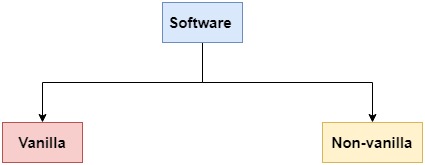1. 引言
在本文中,我们将深入探讨“Vanilla 软件”和“Vanilla 编程”的概念。这些术语在软件开发中经常被提及,但其含义往往容易被误解或泛化。理解这些概念有助于我们在实际项目中做出更合理的技术选型。
2. 软件分类:Vanilla 与非 Vanilla
我们可以根据软件的定制程度将其分为 Vanilla 软件 和 非 Vanilla 软件。

2.1. Vanilla 软件
✅ Vanilla 软件指的是未经过定制、仅包含基础功能的软件。
- 它是通用的,没有根据特定需求进行修改。
- 通常指的是刚发布时的标准版本。
- 允许通过插件等方式进行扩展,但这些通常需要额外授权或购买。
例如,刚安装的 Ubuntu 系统就是一个典型的 Vanilla 系统。它包含了所有默认安装的组件,但没有任何用户自定义的配置。
⚠️ 注意:虽然 Vanilla 软件本身不包含定制,但并不代表它不能被定制。
2.2. 非 Vanilla 软件
✅ 非 Vanilla 软件指的是经过定制、适配特定用户需求的软件。
- 在 Vanilla 的基础上添加了特定功能。
- 可能包含私有插件、定制模块、内核配置等。
例如,如果你在安装 Ubuntu 后对内核进行了重新配置,或者安装了企业级安全插件,那么这个系统就不再是 Vanilla 的了。
3. 代码分类:Vanilla 与非 Vanilla
和软件类似,代码也可以分为 Vanilla 和非 Vanilla,但判断标准略有不同。
3.1. Vanilla 代码
✅ Vanilla 代码指的是完全使用语言原生语法编写的代码,不依赖任何框架、库或插件。
- 优点:轻量、可控性强、便于调试。
- 缺点:开发效率低,需要自己实现很多底层逻辑。
例如,如果我们自己实现一个排序算法(如快速排序)而不是调用标准库,这段代码就可以称为 Vanilla 代码。
public static void quickSort(int[] arr, int low, int high) {
if (low < high) {
int pivot = partition(arr, low, high);
quickSort(arr, low, pivot - 1);
quickSort(arr, pivot + 1, high);
}
}
3.2. 非 Vanilla 代码
✅ 非 Vanilla 代码指的是使用了第三方库或框架的代码。
- 优点:开发效率高,功能丰富。
- 缺点:引入依赖可能带来维护成本、兼容性问题。
例如,使用 Java 的 Arrays.sort():
import java.util.Arrays;
public class Main {
public static void main(String[] args) {
int[] numbers = {5, 3, 8, 1};
Arrays.sort(numbers); // 使用了 Java 标准库
}
}
或者 Python 中使用第三方排序模块:
from sorting import quicksort
arr = [5, 3, 8, 1]
quicksort(arr)
这类代码就属于非 Vanilla 类型。
4. 总结
- Vanilla 软件:通用、未定制,适合标准化部署。
- 非 Vanilla 软件:经过定制,适应特定需求,但维护成本可能更高。
- Vanilla 代码:不依赖任何外部库,完全使用原生语法实现功能。
- 非 Vanilla 代码:使用了框架、库或插件,提高开发效率但也增加了依赖管理的复杂度。
✅ 建议:
- 对于性能要求极高、逻辑简单的场景,可以考虑使用 Vanilla 代码。
- 对于开发周期紧张、功能复杂的项目,使用非 Vanilla 技术栈更合适。
⚠️ 踩坑提醒:不要盲目追求“原生”或“全栈”,应根据项目实际情况选择合适的技术方案。